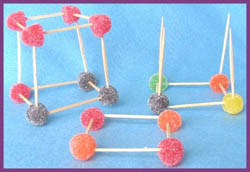Hello,
Our Kids Science Newsletter is published each month. The newsletter includes a question of the month, current science events, and a simple science activity that is fun for kids of all ages.
Question of the Month
What are sunspots?
(answer follows the simple science experiment)
Science Current Events
- Southern Songs of Humpback Whales
- Humpback whales sing to communicate. Recently researchers studying humpback whales in the southern part of the Indian Ocean have found they sing different songs from humpback whales in rest of the ocean. The whales songs have a "southern accent." The humpback whales singing consists of ascending and descending wails, moans and shrieks over and over that can last up to 30 minutes. The songs of the southern humpback whales are distinctly different from whales living in the rest of the Indian Ocean.
- Texas Drought Kills Trees
- The record breaking drought in Texas was the driest year on record in Texas. 2011 was also the second-hottest year since records began. The heat and the drought has killed approximately 5.6 million shade trees in cities and their surrounding areas. Also lost in the drought were approximately half-billion rural, park and forest trees. Recent drenching rains has eased the drought conditions in the state. People living in the cities can once again water their trees as often as needed.
- Bald Eagle Population in Florida
- Bald eagles in Florida have made a dramatic return. The use of DDT in the 1960s almost caused their extinction. The bald eagles sitting on their nests cracked their eggs because the eggshells were so thin due to the DDT. Today Florida has the third largest bald eagle population. Only Alaska and Minnesota has more nesting pairs of bald eagles.
- Volcanoes in Alaska threaten air traffic
- Cleveland Volcano in Alaska lies beneath several major international air routes. In December a blast destroyed a lava dome in the summit of the volcano clearing the throat of the volcano. Pressure is building in the volcano and it may erupt at any time. Blasts of ash could cause airlines to reroute their jets so they would not encounter ash plumes that could damage the airplane engines. Another volcano near Adak, Alaska is also showing signs of increased activity and throwing up small plumes of ash.
Science Trivia
- Yawning appears to be not only a sign of fatigue but also a more general sign of changing conditions within our body. For years it was thought that yawns occurred when there was low levels of oxygen in the lungs. Scientists have discovered that fetuses yawn while still in a mother's womb. Yawning is also contagious and scientists are not sure why.
- Your fingernails take six months to grow from base to tip.
- Martha Washington is the only woman whose portrait has appeared on a U.S. currency note. Her picture appeared on the face of the $1 Silver Certificate of 1886 and 1891. Her portrait appeared on the back of the $1 Silver Certificate issued in 1896.
- The first weather satellite, Tiros 1, was launched on April 1, 1960. It circled the Earth every two hours at heights of 420 to 900 miles above the Earth. It sent back pictures of cloud and snow cover.
Simple Science Activity
Spice Drop Crystals
Introduction
You will begin by creating microscopic crystals that can be joined together to form a large crystal. You will create your crystal out of spice drop candy.

Materials
- Package of spice drop candies
- Box of toothpicks
- Wax paper
Directions
- First, start by creating microscopic crystals by joining 4 spice drops together to form a square with 4 toothpicks.
- Use all the spice drops you have to make these microscopic crystals.
- Place toothpicks on top of the spice drops in one of your squares.
- Place another square on top to form a cube.
- Repeat these two steps so all the squares have formed cubes.
- These represent small crystals.
- Finally, join all your squares of spice drops together to form 1 large crystal.
- After the crystal is built you can keep it or enjoy eating your creation!
Science behind the experiment
Crystals begin growing when molten rock beneath the Earth's surface begins to cool. At first the crystals are microscopic in size. Eventually some crystals can grow extremely large. Miners in some mines have found crystals that weigh tons that grew over long periods of time as the magma (molten rock) cooled in batholiths
Answer to the question of the month
What are sunspots?
Sunspots are often thought of as hot spots on the Sun's surface. They are really cooler spots that develop on the Sun's surface caused by changes in the Sun's magnetic field. The sunspots are approximately 3,600 degrees Fahrenheit cooler than the rest of the Sun's surface.
Please share the newsletter
Please share this newsletter with a friend by forwarding it to them. If you know of a group who might enjoy the newsletter please let them know about it also.
Comments? Ideas? Feedback? I'd love to hear from you. Just reply to this Just For Kids Science Newsletter and tell me what you think!
Sincerely yours,
Myrna Martin
Websites:
www.RingofFireScience.com
www.Kids-Fun-Science.com
www.Kids-Earth-Science.com
www.The-Science-Site.com
|



